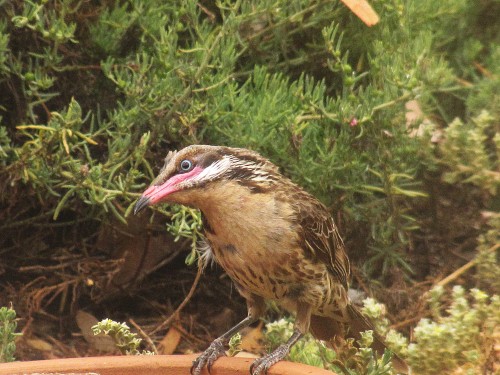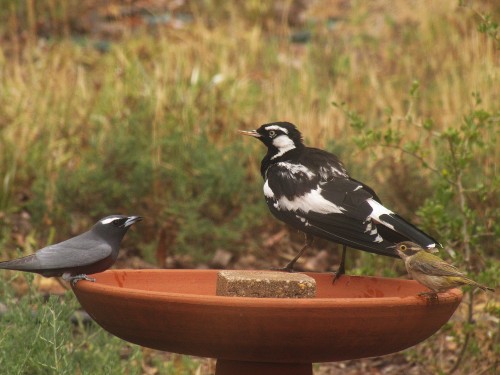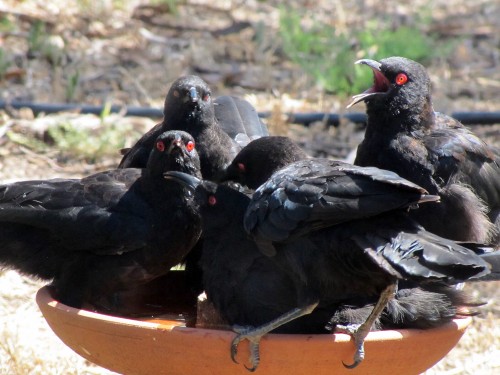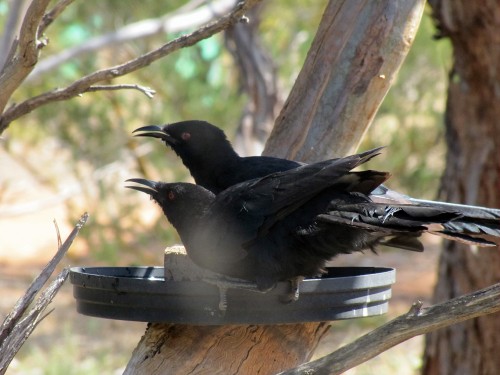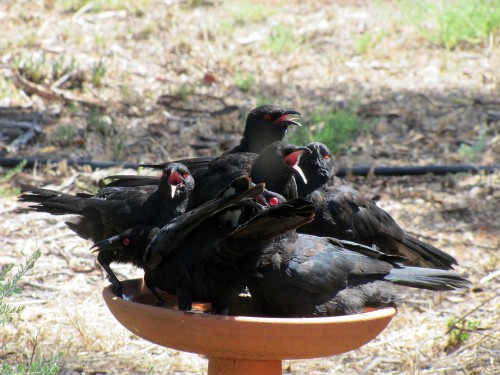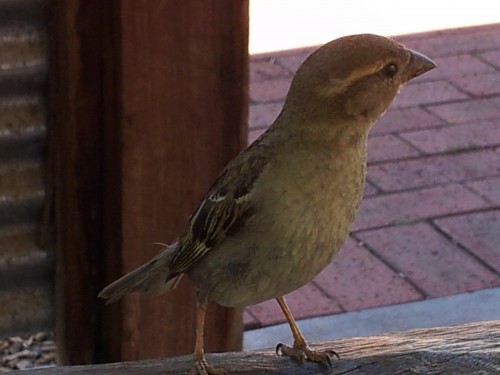Give the birds a treat for Christmas
Merry Christmas Everyone
I wish all of my readers a very merry and blessed Christmas, wherever you are.
I would be really pleased to get greetings from you – just use the “comments” section above.
Birds in the hot Australian sun:
Many parts of Australia are in the grips of an early, very hot summer, and this is especially so here in South Australia. Our capital city of Adelaide last week had a record December heatwave for over a hundred years with a string of 4 days over 40C. Yesterday was another very hot day at around 37C and today, Christmas Day, the forecast is for 38C. This will make it the hottest Christmas Day since 1945.
During hot conditions like these our birds suffer terribly. All of my Australian readers – and readers everywhere suffering in the hot, summer sun – I would like to encourage to buy a bird bath for their garden. Even putting a few old bowls or dishes of water around the garden is better than nothing.
We have had three bird baths strategically placed in our garden for many years. These have been placed so that we can watch from the room which we use the most. Many of the photos which I have used on this site were taken from that room, including that of a Spiny-cheeked Honeyeater shown above, and taken in the heatwave last week..
Two days ago our daughter arrived home for the Christmas break and doubled our number of bird baths. Our children have given us three new bird baths. I hope this doubles the number of photos I can take!
I hope that you have a great Christmas and a wonderful New Year.
Trevor
Further reading:
- Spiny-cheeked honeyeater on a hot day
- Make room for me – White-winged Choughs get a little crowded at the bird bath
- Time for a bath – a list of bird and non-bird visitors to our bird baths
Make room for me
We have many different species come to visit our bird baths. They come either for a drink or for a bath – sometimes both. Many of these species are quite small, such as the thornbills and pardalotes. At the other end of the scale where size is considered would have to be the Little Ravens, Grey Currawongs and of course, the White-winged Choughs, featured in today’s photos.
This series of photos was taken during our recent heat wave in South Australia. Our capital city Adelaide saw a 117 year record broken: 13 days over 40C over the summer, previously 11 days. Here in Murray Bridge we certainly have more than that. During hot weather the birds flock to the water throughout the day. Refilling the baths is a daily task.
The White-winged Choughs all seem to crowd onto the one bird bath, each wanting a piece of the action. It is quite comical to witness the jostling and arguing over the prime positions. Sensible birds take up a position on one of the other bird baths nearby.
On the road again part 2
Ouyen to Narrandera
On the afternoon of the first day of our trip to Sydney we travelled from Ouyen in Victoria to Narrandera in NSW. From Ouyen to Tooleybuc we didn’t see all that many birds, just the occasional Australian Magpie, small groups of White-winged choughs foraging on the roadside, several Willie Wagtails seeking out insects and solitary ravens flying across the road or the adjacent farm paddocks. Usually along here we see various parrot species but on this day we only saw a few Galahs.
If we had stopped at Tooleybuc for a break we might have added quite a few species to my growing list. The River Murray runs through the town and this environment offers much to a wide range of species. The same applies a few minutes later in the afternoon when we cross the Edward River near the township of Kyalite. We also by-pass Balranald and the Murrumbidgee River there.
Between Balranald and Hay we often stop for a break at the Ravensworth Rest Area. I’ve often found a good range of birds at this location. This time, however, we didn’t have the need to stop. Along this stretch of road we saw an Australian Pelican sitting on the bank of a farm dam. I figured that there mush be fish in the dam.
Near the rest area we saw Nankeen Kestrel, Little Eagle and Australian Ravens. A few kilometres back we had seen a small group of Emus. This was in complete contrast with our trip earlier in the year when we saw over 80 Emus on this stretch of road.
Sorry, but I have no photos to show taken during this section of our journey. Perhaps tomorrow?
Good birding.
On the road again
We are on the road again. To be more precise: we have been on the road and are now in Sydney for about a month staying with family for Christmas. We left just over a week ago and travelled from home in Murray Bridge, South Australia, to my son’s home in Artarmon in two days of many hours in the car. Although the distance is just over 1300km we enjoy the journey, taking note of the changing environments as we go.
All the way we are on the lookout for birds. At certain points along the way we stop for meal breaks, or to refuel. On these occasions I usually jot down the birds observed during our break. Additional lists are sometimes made as we drive along, usually when my wife is driving. If either of us sees something special or out of the ordinary I will make a note of that too.
During the morning of the first day we saw many of the usual species seen along the road from Murray Bridge to Ouyen in Victoria. This is predominantly mallee eucalypt country used for wheat and sheep farming. Along the way we saw several family groups of White-winged Choughs. It always amuses me that they do not merely walk or hop along the ground; it’s more of a swagger. If pressed hard they will fly off, their white wing patches showing up clearly. This easily identifies them from the many Australian Magpies and Little Ravens along this stretch of highway.
Also along this stretch I am also on the lookout for the way the magpies change from the white-backed sub-species to the black-backed. Intermediate hybrids are also worth looking for. As for the ravens it is a harder task. The further east one travels the more Australian Ravens can be found. The only sure way of telling them apart from the Little Ravens is to hear them call, not a practical solution driving at 110kph.
Along this first leg of the journey we also saw a few Grey Currawongs as they glided across the road in front of us, many Willie Wagtails fluttering around in search of breakfast, the occasional Nankeen Kestrel soaring or hovering over the fields, and flocks of Galahs glowing pink in the morning sun. A highlight was several brief sightings of Dusky Woodswallows, always a nice species to see.
Morning tea at Lameroo added Welcome Swallows, Australian Wood Duck, Crested Pigeon and Magpie Lark to the list. I didn’t add the feral domestic ducks which live around the artificial lake.
Coming into Ouyen for lunch I saw the only Brown Falcon sighted on the journey to Sydney. Typically, it was perched on the pole of a telephone line. While having lunch a female House Sparrow cheekily perched on the picnic table about 30cm from my lunch. It was close enough to get a few good shots with my phone (see below).
Other species added to my growing list while we ate lunch included Spiny-cheeked Honeyeater, European Blackbird, Common Starling, Yellow-throated Miner, Singing Honeyeater and White-plumed Honeyeater.
Tomorrow: from Ouyen, Victoria to Narrandera, NSW.
Angry birds in our garden
Last week I wrote about the young Grey Currawongs being fed by the adults in our garden. They are still hanging around and squawking noisily whenever they get hungry – which seems to be most of the time.
Yesterday morning I was doing some reading in our sun room when a sudden screeching noise outside interrupted my thoughts. I grabbed the binoculars (but not the camera, alas) and raced outside. High up in the sky above our house a Little Eagle was soaring around on the gentle breeze, obviously looking for something to eat for lunch.
The eagle seemed oblivious to the fact that both currawong parents were attacking it, screeching loudly in order to chase away the offending predator. Slowly, almost nonchalantly, the eagle glided away out of sight and the currawongs calmed down and resumed feeding the young ones., and peace resumed in the garden.
More angry birds
The currawongs are not the only angry birds resident in our garden. The Australian Magpies chase off the Grey Currawongs and the White-winged choughs, the Willie Wagtails are constantly attacking all three already mentioned and the Red Wattlebirds appear to have a distinct dislike towards anything with wings, including the hapless tiny Pardalotes. This latter conflict is a real miss-matched war: wattlebirds are bout 36cm long compared with the pardalotes weighing in at only 8cm. I reckon the wattlebirds are the big bullies in our little patch.
